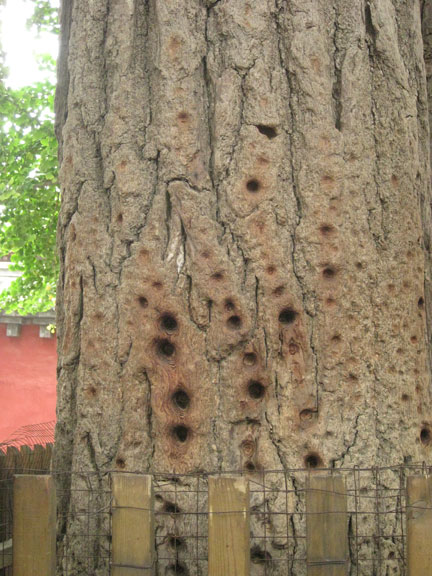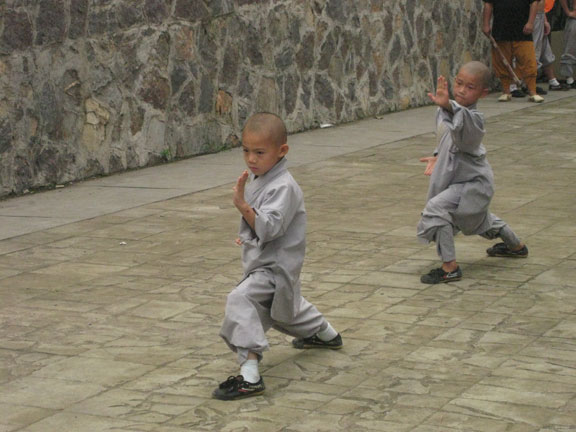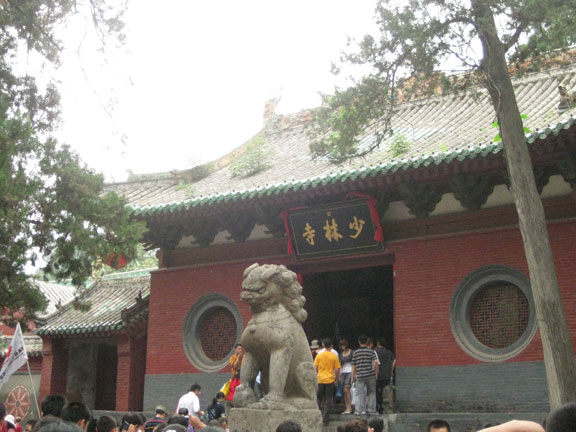
I’ve never taken a kung fu class (or karate) and I’ve only seen one Bruce Lee flick yet I have always wanted to go to Shaolin Temple. I’ve read Matthew Polly’s book about training at Shaolin (twice) and even he desribes it as touristy and yet I and have always imagined it as a serene mystical place where the body and mind combine to make the perfect peaceful, but dangerous monk. Imagine my surprise when I realized we were only a couple of hours away from the temple and I would get my chance to see it in person.
The history of Shaolin Temple is mixed with lore and big empty patches so fleshing out the facts is quite difficult.
What is known is that the original temple was built around the year 500. But it was a normal temple, with pudgy meditating, book-loving monks in the beginning. It wasn’t for another 30 years that things began to change with the arrival of a monk from India named Damo. Much myth and legend swirls around Damo. Most famously he is said to have meditated in a cave for 9 years without moving or speaking. Today, the cave is a sacred site (and major tourist attraction).
Anyway, he began to train the Shaolin monks because he felt that to be a good monk, you had to have a sharp mind and a strong body. The exercises were based on the movements of animals, such as the snake, praying mantis and so on. Originally they were just exercises, nothing more. But at some point they became a martial art. Some people theorize that the Shaolin Temple was in the secluded mountainside and was probably the frequent victim of bandit attacks and so the monks had to learn to defend themselves.
Whatever it was, Shaolin kung fu flourished, and with it so did the temple. It is said that during the Tang Dynasty (618-907) some Shaolin monks saved the life of the emperor through their smooth moves. More and more monks learn of this new form of martial arts and it begins to travel to new temples and new areas so that people outside Shaolin were practicing Shaolin kung fu.
But despite the popularity, things didn’t always work out for the temple, or the inhabitants. One legend said that 128 Shaolin monks, at the emperor’s command, defeated 10,000 attacking warriors. As soon the war was over the monks were invited to join the emperor’s guard but declined choosing to go back to Shaolin instead. The emperor became afraid of these powerful warriors who weren’t under his command and he decided to wage war. With the help of a renegade monk (who knew all of the temple’s secrets) he managed to attack the temple and kill almost all of the monks. The 5 surviving monks went into hiding and are now known as the 5 Ancestors. But eventually the temple was rebuilt and repopulated.
The 1900’s proved to be another bad time for the temple. War ravened China and Shaolin Temple was just another victim. In 1928 a war lord set a major fire to the temple. At this point the temple housed hundreds of ancient sacred texts which were destroyed. (Only a few manuscripts were saved.) They were going to rebuild the temple, but then the Japanese took possession of it in the early 40’s wreaking further havoc. Then Mao took control and we all know how cultural relics flourished during his tenure.
So the temple was pretty destroyed, never recovering from the 1928 fire or the Cultural Revolution. By 1978 only 9 ragtag monks lived in the crumbling temple, and they were half starved and poor. Then a funny thing happened. A little movie called Shaolin Temple came out in 1982 (staring a young Jet Li in his first feature film) and people began to take interest in the temple once again.
The government, which had been responsible for the destruction in the past, was now responsible for the temple’s rebirth. Local officials realized that money could be made from tourism to the temple, so they went about fixing it up, getting monks to come back, and even bringing back some Shaolin masters from other parts of the country to teach kung fu.
That means that most of the buildings in the complex are new, brand spanking new. Many have been built within the last 10 years which was a bit of a disappointment to purists. The place is now far more than a temple. It is a complex with a giant entrance gate (and a giant ticket price to go along with it) a performance hall (with shows every hour) and electric cars to whisk you from the gate to the temple. There are of course some signs of the past such as finger-sized holes in trees from hand kung fu, and depressions on a stone floor in one room from decades of standing poses.

But the temple is now mostly a tourist attraction. You could barely see the trees with the finger depressions from the hoards of tourist and tour guides milling around taking pictures. Also it was a bit disappointing to see that Shaolin Temple was, well, just a temple. I have seen dozens of temples in my time here in China and I just expected something, I don’t know, different at Shaolin. Ryan and I kept hoping we would find a group of monks in orange robes and shaved head doing kicks and lunges in a dusty courtyard.
In fact, it wasn’t until we were on the way out we saw some kung fu (aside from the show in the performance hall that is). We noticed a group of tourists behind one of the buildings and went over to check it out. It was a group of 20 or so small children practicing their poses. Real kung fu! Kids in robes! Shaved heads!

Also, on our way out of the complex we saw hundreds of kids in matching outfits out in the fields practicing kicks, standing at attention, boxing etc. It looked more like activity hour at summer camp then kung fu training, but seeing as how it was summer, the whole thing was probably some Shaolin summer camp that charges you twice the price to be close to the temple.
It’s not that I hated the place, I had a lot of fun. But I had the tourist type fun that comes from going to Sea World or Graceland for the day. I mean, we even spent $3 to get our picture taken with some monks that pose for you (and I love the picture). Tourism saved Shaolin Temple, but at the same time, maybe it destroyed a little bit of it as well.



Hi Becky!
There is a picture of a statue of two monks fighting outside the Shaolin Temple. Google images linked me to your page, “https://beckyances.net/2010/09/02/kicking-ass-at-the-shaolin-temple/” but I don’t see that picture on your site. Do you still have this photo and may I use it or buy it for my webpage?
Thank you!
Tim